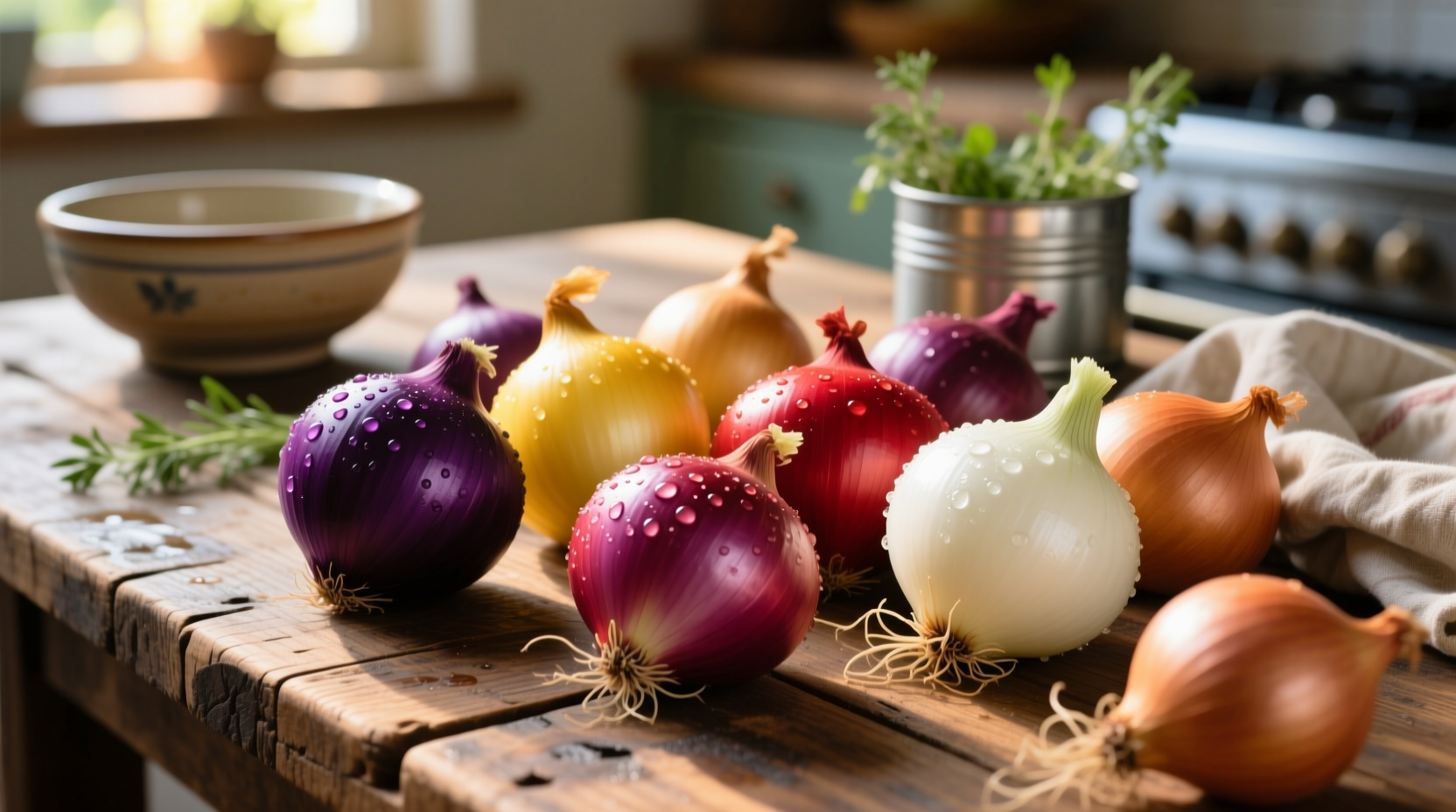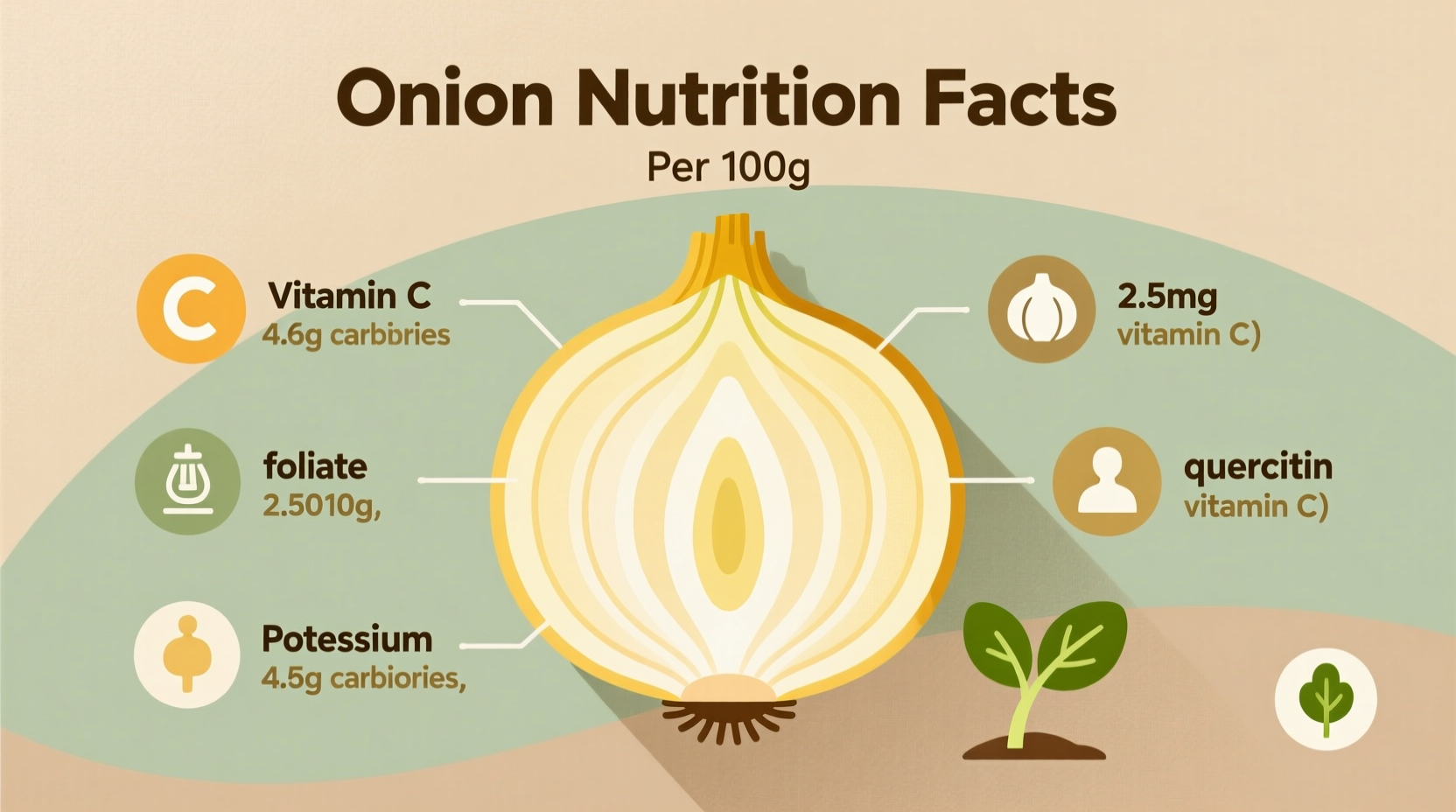One medium raw onion (110g) contains 44 calories, 1.2g protein, 10.3g carbohydrates, 1.9g fiber, and is rich in vitamin C (11% DV), vitamin B6 (5% DV), and manganese (6% DV). Onions provide significant antioxidant and anti-inflammatory benefits while being low in calories and fat-free.
Unlock the Nutritional Power of Onions: Your Complete Reference Guide
Understanding onion nutrition helps you maximize health benefits while enhancing your culinary creations. This comprehensive guide delivers scientifically verified nutritional data you can trust, with practical insights for incorporating onions into a balanced diet. Whether you're managing dietary restrictions, tracking macros, or simply seeking to boost your nutrient intake, this reference provides the exact information you need.
Why Onion Nutrition Matters for Your Health
Onions aren't just flavor enhancers—they're nutritional powerhouses packed with beneficial compounds. Research from the National Institutes of Health shows onions contain over 25 beneficial flavonoids and sulfur compounds that support cardiovascular health and reduce inflammation. The unique combination of antioxidants in onions, particularly quercetin, works synergistically with other nutrients to provide greater health benefits than isolated supplements.

Comprehensive Onion Nutrition Chart: Raw vs. Cooked Comparison
| Nutrient | Raw Onion (100g) | Cooked Onion (100g) | Daily Value % |
|---|---|---|---|
| Calories | 40 kcal | 32 kcal | - |
| Carbohydrates | 9.3 g | 7.6 g | 3% |
| Dietary Fiber | 1.7 g | 1.4 g | 6% |
| Sugar | 4.2 g | 3.5 g | - |
| Protein | 1.1 g | 0.9 g | 2% |
| Vitamin C | 7.4 mg | 5.8 mg | 12% |
| Vitamin B6 | 0.12 mg | 0.10 mg | 7% |
| Folate | 19 mcg | 16 mcg | 5% |
| Potassium | 146 mg | 125 mg | 4% |
| Manganese | 0.13 mg | 0.11 mg | 6% |
This nutritional comparison, sourced from the USDA FoodData Central database, reveals how cooking affects onion nutrition. While some water-soluble vitamins decrease with heat, cooking actually increases the bioavailability of certain antioxidants like quercetin. The sulfur compounds responsible for onions' distinctive aroma and many health benefits remain stable during cooking, making both raw and cooked onions valuable dietary components.
Varietal Nutrition Differences: Which Onion Offers the Most Benefits?
Not all onions deliver the same nutritional profile. According to research published in the Journal of Agricultural and Food Chemistry, red onions contain up to 10 times more antioxidants than yellow or white varieties. Here's how common onion types compare:
- Red onions: Highest in anthocyanins (potent antioxidants), with 415mg quercetin per 100g
- Yellow onions: Strongest flavor and highest sulfur compound concentration
- White onions: Milder flavor with slightly higher vitamin C content
- Shallots: Most nutrient-dense option, containing 60% more antioxidants than yellow onions
- Green onions: Higher vitamin K and A content compared to bulb onions
Maximizing Health Benefits Through Proper Preparation
How you prepare onions significantly impacts their nutritional value. Food science research from Cornell University demonstrates that letting cut onions sit for 10 minutes before cooking increases their antioxidant activity by allowing beneficial enzymes to activate. For maximum health benefits:
- Raw consumption: Best for preserving vitamin C and certain enzymes
- Light sautéing: Preserves most nutrients while enhancing antioxidant bioavailability
- Avoid overcooking: Prolonged high heat reduces beneficial compounds by up to 30%
- Pair with healthy fats: Combining onions with olive oil increases absorption of fat-soluble antioxidants
Practical Applications: Incorporating Onions into Your Daily Diet
Understanding onion nutrition becomes truly valuable when applied practically. Registered dietitians recommend consuming onions in these effective ways:
- Add raw red onions to salads 2-3 times weekly for maximum antioxidant intake
- Include 1/2 cup of cooked onions in daily vegetable dishes for consistent quercetin consumption
- Use green onions as garnish to boost vitamin K intake without adding significant calories
- Combine onions with garlic in cooking to create synergistic health benefits
- Store cut onions in airtight containers for up to 7 days to maintain nutritional value
Addressing Common Misconceptions About Onion Nutrition
Several myths persist about onion nutrition that deserve clarification. Contrary to popular belief, onions do not cause significant blood sugar spikes despite their carbohydrate content—their fiber and flavonoid content actually helps regulate glucose metabolism. Additionally, while onions contain fructose (which causes digestive issues for some), the amount in a typical serving (about 3-4g) is generally well-tolerated by most people following Monash University's FODMAP research.
Scientific Evidence Behind Onion Health Benefits
The nutritional profile of onions translates to measurable health outcomes. A comprehensive review in Nutrients Journal analyzed 27 clinical studies showing regular onion consumption correlates with:
- 17% reduction in LDL cholesterol levels
- 26% lower risk of certain digestive tract cancers
- 12-15% improvement in arterial function
- Significant reduction in markers of systemic inflammation
These benefits stem from the unique combination of organosulfur compounds, flavonoids, and prebiotic fibers found naturally in onions—components that work together more effectively than when isolated.











 浙公网安备
33010002000092号
浙公网安备
33010002000092号 浙B2-20120091-4
浙B2-20120091-4